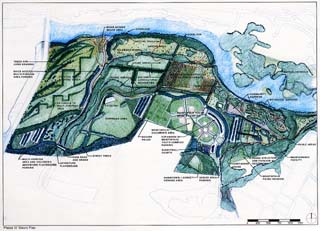Naked City
Park and Parcel
By Dan Oko, Fri., April 28, 2000

Some say "compromise" is a dirty word, but when it comes to the new Colorado River Park below Longhorn Dam, just the opposite appears to be true. A process that looked to be filled with interminable wrangling and name calling at its outset has evolved under the careful stewardship of the nonprofit Austin Parks Foundation into a bona fide success story with minimal casualties. Thus, Austinites can look forward to a final plan that aims to set aside the riverbank riparian area, provide needed neighborhood playing fields, and offer a destination that may one day rival Zilker Park as the pride of the city.
Of course, nothing's that simple. Still, at this stage in the planning process -- with the blueprint that will guide the hand of park developers nearly complete -- most stakeholders find themselves in a self-congratulatory mood. According to Tim Fulton, executive director of the parks foundation, the immediate goals for the park include getting the plan into final form and submitting it for approval to the city Parks Board and the Austin Parks and Recreation Department. After that, but not before a biological assessment of the area takes place, renovation of the property will start.
The 363-acre site in Southeast Austin, which the city acquired through donations and land buys over the past three decades, is clearly in need of a little TLC. In '98, voters also passed a $10 million bond for development of the park, but Fulton says that money will cover only about a third of the cost of developing the park. A series of town meetings last winter elicited numerous requests from citizens concerning park amenities. Little League fields, soccer fields, and natural areas were among the items that topped the list.
Early in the planning process, the constituencies behind such endeavors didn't all see eye to eye. For one thing, amid all the clamor for amenities, East Austin residents wanted to make sure that they didn't get dumped on -- the park was in their neighborhood, after all. Likewise, questions lingered concerning how much development the park could sustain before losing the natural character that makes the land so attractive.
Susana Almanza of People Organized in Defense of Earth and Her Resources (PODER) appears happy with how things have turned out, saying that neighborhood interests and environmental concerns have been satisfied through the planning process. "We're very pleased with what they've come up with," Almanza says. "We can have a place for the animals, large and small, and a place where people can play and enjoy themselves."
But with the nearby Pleasant Valley Sportsplex, a privately owned facility, closing down before the year is out, and some of the more recreation-intensive plans tabled for the time being, some groups remain reserved in their celebration of Austin's new park. Sportsplex owner Gerald Daugherty will be selling 25 of his 35 acres to developers, eliminating five diamonds long used by Austin's softball leagues. The land, he says, had just grown too valuable to maintain as open space, and will most likely be turned into housing. "Tell me what's more important, ballfields or places to live?" Daugherty asks.
The loss of Daugherty's fields, combined with the possibility that the 11 softball diamonds that make up the on-site Kreig Fields will be moved, has created a stir in the local softball community. Austin Softball Association president Eileen Walsh says her group already struggles to get the city to deal with inadequate facilities, and Kreig Fields -- though in disrepair -- represents one of the few centrally located public areas available for league play. "We would rather not see those fields moved," she says. "The fields do need to get redone, but our priority is to get Kreig shipshape."
Fulton, who has met with Walsh, says he's sympathetic to the needs of the softball players, and will be seeking alternative approaches. But part of the problem stems from the fact that the fields are located on the flood plain. Given the sandy material that forms their infields, it seems likely that until the fields are relocated, they will continue to erode into the Colorado River. In the end, Fulton says, the question of what to do with Kreig will have to wait until later.
City Council Member Beverly Griffith, long a parks champion, says she's looking forward to the development of the park. As for the need for more fields and the emerging open space crisis, Griffith hopes that people watching the process recognize that urban parks can be all things to almost everybody.
"We've got a great product," says Griffith, "and should have no problem creating what I believe will be one of the best urban parks in the whole country. We have enough land for both developed recreational space and natural areas, and should be able to accommodate both a preserve and developed areas."
Got something to say on the subject? Send a letter to the editor.








